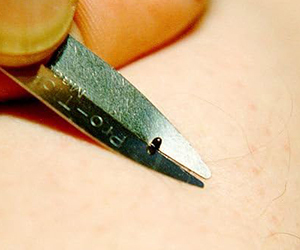- Simple, easy-to-use
- Removes crawling or attached ticks
- No human contact with the tick
- University lab tested & recommended
- Helps reduce the risk of Lyme Disease
- Great for people & pets
- Featherlight – 0.045 oz (1.27 g)
Pro-Tick Remedy® is a simple single-motion tick remover that’s easy use, university tested and recommended, and proven in removing disease-carrying adult and nymph ticks from both people and pets. Ticks are easily removed by placing the tick in the deep notch and slowly sliding the remover forward to detach and capture the tick without contact. Pro-Tick is featherlight at just 0.045 oz (1.27 g) without the magnifier and chain, fits easily in your first aid kit, and will help reduce the risk of Lyme Disease.
Pro-Tick is intentionally skinny and thinner than a credit card so it smoothly slides under a tick without crushing it. And short so the tick comes off intact instead of breaking from too much leverage. The package includes a tick remover, 5x magnifier, tick ID card, and a detailed tick tutorial. The magnifier can help you see the tiny tick and the tick ID card will help identify the most common ticks found in the US. Minimalists might take just the tick remover. The flat shape fits nicely in your kit. Pro-Tick is easy to use and easy to carry.
Ticks are carriers for many infectious diseases. Lyme Disease is one of the fastest growing vector-borne diseases in the United States and is becoming widespread. Lyme Disease results in fatigue, flu-like symptoms, and often a bull’s eye pattern rash and if left untreated infection can spread to joints, heart, and nervous system. Early diagnosis and treatment with antibiotics are important. Ticks must bite you to spread their germs. Crawling ticks that have not attached could not have spread germs. Research has shown the faster you remove an embedded tick, the lower the risk of disease transmission. Check for ticks daily and remove them as soon as possible.
Tick exposure can occur year-round, but ticks are most active during warmer months. To best avoid ticks, know where to expect ticks, treat clothing and gear with permethrin, use insect repellent, avoid wooded and brushy areas with high grass and leaf litter, and stay on-trail and in the middle of the trail. After outdoor activities, check your clothing for ticks, examine gear and pets, shower within a couple hours, and check your body for ticks focusing on underarms, in and around ears, inside belly button, back of knees, in and around hair, between legs, and around the waist.
What Ticks Do
- Ticks wait on a blade of grass or bush for a host to come by.
- They find a host by sensing breath (CO2), heat, and vibrations using sensors on their front legs.
- They reach out with their legs and grab on to clothing or an animal’s fur as they go by.
- The tick finds a way to a suitable place on the body and uses its chelicerae to slice a hole in the skin. No pain will be felt.
- The tick inserts its hypostome into the slice while excreting tick cement around the hypostome to help hold itself in place.
- Then the tick draws blood for 30-72 hours, expanding in size as if feeds.

How to Remove Ticks
- Place wide part of notch on the skin near tick. It’s best to approach from the rear of the tick, but any direction will work.
- Apply slight downward pressure on the skin and slide the remover slowly forward so the small part of the notch is framing the tick. Continuous forward sliding motion detaches the tick. Do not pry, lever, or lift the remover, just slide forward.
- Once the tick is detached it can be disposed or saved for testing.
- Treat the wound as needed.
- Clean the tick remover with alcohol or similar disinfectant.
Myths Resolved
Ticks fly, jump, or drop from trees
Wrong. They wait on a blade of grass or twig for a host to go by then hop on and find a place to attach and feed.
Ticks burrow under the skin
Not true. Ticks only insert their hypostome about an 1/8 in. (3 mm) into the skin.
Petroleum jelly, nail polish, alcohol, or a hot match makes the tick back out
It has been scientifically proven this does not happen. When these techniques are used, ticks will activate their defenses and regurgitate infected fluids into you, potentially giving you a disease.
Rotating the tick will release it from the skin
Ticks have barbs on the hypostome, not threads. You can’t unscrew a tick.
If a tick head breaks off in the skin, another tick will grow from it
Absolutely not. An infection will result, much like a splinter, and will work its way out of the skin over time.
Hard ticks are small and soft ticks are big
Hard ticks have a scutum or shield-like plate on their back. Soft ticks have no scutum. Most ticks are hard ticks.
Getting Lyme Disease won’t happen to me
Certainly could happen. Lyme Disease is one of the fastest growing infectious vector-borne diseases in the United States and is becoming widespread. Never mind all the other diseases ticks transmit.
Specifications
Material
Tick Remover: Tempered Steel
5x Magnifier: Plastic
Dimensions (LxWxD)
Tick Remover: 2.2 x 0.49 x 0.073 in. (5.6 x 1.3 x 0.19 cm)
5x Magnifier: 1.7 x 1.0 x 0.17 in. (4.3 x 2.6 x 0.42 cm)
Weight
Tick Remover + 5x Magnifier + Ball Chain: 0.178 oz (5.06 g)
Tick Remover: 0.045 oz (1.27 g)
5x Magnifier: 0.097 oz (2.75 g)
Ball Chain: 0.04 oz (1.14 g)











